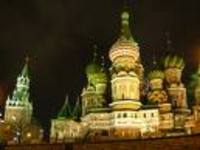Christmas in Russia - 6 January, 2008
Russia celebrates the Orthodox Christmas on 7th January. We present a brief summary of the most common traditions, looking at some symbols from the Orthodox Christmas, at what people eat, and at the fundamental meaning of this date.

Saint Nicholas is the Patron Saint of Russia, sailors and children, the benevolent figure who brings presents on 6th or 25th December or 6th January, depending on the country, religion or culture. In Russia Christmas Eve is celebrated on 6th January (Julian calendar) and the following 12 days are Holy Days, to celebrate the birth of Christ.
Saint Nicholas existed in flesh and blood. He was born in 217 AD, in Mira, Asia Minor, the city of which he became Bishop in the 4th Century. He was connected to giving and sharing due to two stories: he saved three daughters of a poor man from prostitution by giving each one a bag of gold; in another story, he saved three navy officers from death, by appearing in their dreams and telling them what to do.
Originally, in most of Europe, presents were given on Saint Nicholas’ Day, 6th December. However this was changed when in the 4th century AD, Pope Julius I (337-352) fixed the 25th December as the date of Christ’s birth because it coincided more or less with the Roman festival of Saturnalia and the Pagan Germanic and Celtic festivals of the Winter Solstice on 21st December. The habit of building nativity scenes to celebrate Christ’s birth began in the 13th century.
The Orthodox Church then started celebrating the birth of Christ on the day of Epiphany (day of adoration, 6th January), when the Three Kings brought presents to Jesus in the stable – because according to the Julian calendar, Christmas is out of phase with the Gregorian (Western) calendar by 2 weeks. This is the day when Christmas is celebrated in Russia but the one who brings presents is Ded Moroz (Grandfather Frost) and Snegoroushka (the Snow Girl). Ded Moroz is maybe the original Father Christmas, with his long white beard and long tunic-like clothes.
In Russia, Christmas Eve is celebrated with various typical dishes, in a family reunion and in some houses, places set at the table for family members who died. The meal (the Holy Supper) is large, because it ends a period of fasting. However, meat is not eaten. The party begins when the first star appears in the sky. On the table, a white cloth, symbolizing the white swaddling cloth around the baby Jesus. Some people place straw around the table to symbolise simplicity, evoking the manger where the baby Jesus was born. A candle is lit in the centre of the table (the Light of Christ). The Christmas Tree (Yolka) is decorated before the meal.
Traditionally, the Father of the family says the prayer Our Father and says “Christ is born!” The family members say “Glorify Him!” and the mother makes the sign of the cross on all present, saying “In the name of the Father, the Son and the Holy Spirit, may you have sweetness, and many good things in life in the coming year”.
The family group then shares the bread, and each one places his piece of bread in honey (sweetness) and then in pieces of garlic (bitterness, in life).
The food varies from region to region, but among the more traditional dishes are the following 12 dishes, symbolizing the 12 disciples:
Kutya, a grain porridge (wheat, etc), raisins, honey, and poppy seeds. The grains symbolise hope; honey – happiness; the seeds – peace. The Kutya is eaten from the same plate, symbolising togetherness;
Pagach, a large bread, placed beside the candle;
Zaprashka, soup with onion, flour and sometimes mushrooms;
Chopped garlic;
Honey;
Roast cod or other fish;
Fresh or dried fruit;
Nuts;
Slow cooked bean stew;
Peas or lentils;
Small boiled potatoes;
Bobal’ki (small biscuits with seeds or cabbage)
Drinks
After the Holy Supper, the presents are opened and the family goes to the Mass, returning home late. Traditionally, people walk through the villages, singing songs, Kolyadki, (the name comes from the Goddess Kolyada, who brought longer days after Winter).
As we can see, the Russians, just like any other people, are a happy people, they like smiling, they like laughing, celebrating with their families, they like and promote peace, they like being happy and like wishing well-being to all, not only their families but also to everyone around the world – a world which could do a little more towards understanding them as they are, and not how they are protrayed as being.
Timothy BANCROFT-HINCHEY
PRAVDA.Ru
Subscribe to Pravda.Ru Telegram channel, Facebook, RSS!





